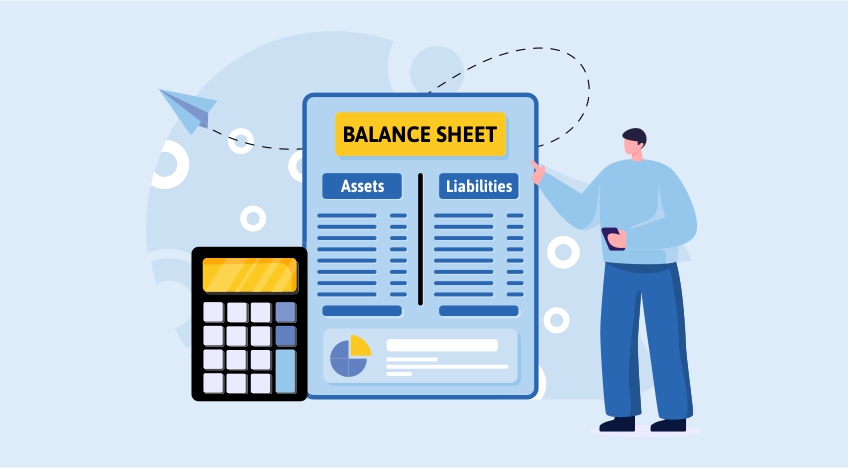

Estimated Balance Sheet
Preparing projected and estimated balance sheet, one must anticipate the financial standing of a business at a future date by using projected information and assumptions.
Here are the steps to prepare a projected and estimated balance sheet:
1. Gather Relevant Data:
Collect historical financial statements, including balance sheets, income statements, and cash flow statements. Analyze trends and patterns in the data to inform your projections. Additionally, gather information on future business plans, anticipated sales growth, investment plans, and any other relevant factors that will impact the financial position of the business.
2. Determine the Projection Period:
Decide on the period for which you want to project the balance sheet. It could be for the upcoming year, several years, or any specific time frame based on your needs and objectives.
3. Forecast Assets:
Start by projecting the assets of the business. This includes current assets (such as cash, accounts receivable, inventory) and fixed assets (such as property, plant, and equipment). Estimate the growth or decline in each asset category based on expected sales, production levels, investment plans, and other relevant factors.
4. Estimate Liabilities and Equity:
Next, estimate the liabilities and equity of the business. This includes current liabilities (such as accounts payable, short-term debt) and long-term liabilities (such as long-term debt, deferred taxes). Determine the changes in liabilities based on expected expenses, payment terms, financing arrangements, and other factors. To determine the equity, subtract the total liabilities from the total assets.
5. Consider Assumptions:
Clearly define the assumptions used in the projections. These can include sales growth rates, cost structures, pricing strategies, interest rates, tax rates, and any other relevant factors that may impact the balance sheet. Ensure that the assumptions are realistic, based on market conditions, industry trends, and historical performance.
6. Calculate Financial Ratios:
Calculate key financial ratios based on the projected balance sheet, such as current ratio, debt-to-equity ratio, and return on assets. These ratios provide insights into the financial health and performance of the business.
7. Review and Refine:
Review the projected and estimated balance sheet for accuracy, reasonableness, and coherence. Validate the projections against industry benchmarks, historical performance, and external factors that may influence the business. Make necessary adjustments and refinements to ensure the projections reflect a realistic financial position.
8. Document and Communicate:
Document the assumptions, methodology, and key findings of the projected and estimated balance sheet. Clearly communicate the limitations of the projections and the uncertainties associated with future outcomes. Share the projections with relevant stakeholders, such as management, investors, or lenders, to provide insights into the anticipated financial position of the business.
It’s important to note that preparing projected and estimated b/s are based on assumptions and future expectations. They are subject to change as actual data becomes available and business conditions evolve. Regularly review and update the projections to ensure they remain relevant and useful for decision-making.
FAQs
1.What is a projected balance sheet?
- A projected balance sheet is a financial statement that estimates a company’s financial position at a future date, showing expected assets, liabilities, and equity based on forecasts.
2. Why is a projected balance sheet important?
- It helps businesses plan for the future by providing insights into expected financial health, aiding in decision-making, budgeting, and attracting investors or lenders.
3. How do you start preparing a projected balance sheet?
- Begin with a historical balance sheet to understand the current financial position, then gather data on expected changes in revenues, expenses, and investments.
4. What time frame should a projected balance sheet cover?
- It typically covers a period of one year but can extend to three to five years for long-term planning.
5. How do you estimate future revenues?
- Future revenues can be estimated by analyzing past performance, considering market trends, and incorporating growth rates based on industry standards or company goals.
6. What factors affect projected assets?
- Projected assets can be influenced by anticipated sales growth, capital expenditures (like buying new equipment), and changes in inventory levels.
7. How are liabilities estimated?
- Liabilities are estimated based on expected future expenses, loan repayments, and any projected increases in accounts payable or other obligations.
8. What role does equity play in a projected balance sheet?
- Equity represents the owners’ residual interest in the company. It’s affected by net income projections (from the income statement) and any expected changes in capital contributions or withdrawals.
9. How often should a projected balance sheet be updated?
- It should be updated regularly, at least annually, or whenever there are significant changes in business conditions, strategies, or market environments.
10. What tools can help prepare a projected balance sheet?
- Financial modeling software, spreadsheets (like Excel), and accounting software can assist in creating and updating projected balance sheets effectively.
For further details access our website https://vibrantfinserv.com
Contact:В В В В 8130555124, 8130045124
Whatsapp:В В https://wa.me/918130555124
Mail ID:В В В В В В operations@vibrantfinserv.com
Web Link:В В В https://vibrantfinserv.com
FB Link:В В В В В В https://fb.me/vibrantfinserv
Insta Link:В В https://www.instagram.com/vibrantfinserv2/
Twitter:В В В В В В https://twitter.com/VibrantFinserv
Linkedin:В В В В https://www.linkedin.com/in/vibrant-finserv-62566a259/
